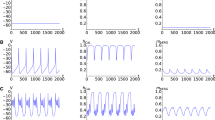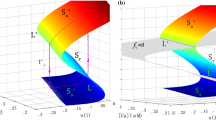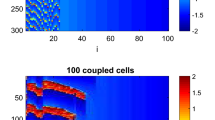Abstract
We combine bifurcation analysis with the theory of canard-induced mixed mode oscillations to investigate the dynamics of a novel form of bursting. This bursting oscillation, which arises from a model of the electrical activity of a pituitary cell, is characterized by small impulses or spikes riding on top of an elevated voltage plateau. Oscillations with these characteristics have been called “pseudo-plateau bursting”. Unlike standard bursting, the subsystem of fast variables does not possess a stable branch of periodic spiking solutions, and in the case studied here the standard fast/slow analysis provides little information about the underlying dynamics. We demonstrate that the bursting is actually a canard-induced mixed mode oscillation, and use canard theory to characterize the dynamics of the oscillation. We also use bifurcation analysis of the full system of equations to extend the results of the singular analysis to the physiological regime. This demonstrates that the combination of these two analysis techniques can be a powerful tool for understanding the pseudo-plateau bursting oscillations that arise in electrically excitable pituitary cells and isolated pancreatic β-cells.












Similar content being viewed by others
References
Benoit, E. (1983). Syst‘emes lents-rapides dans r3 et leur canards. Asterisque, 109–110, 159–191.
Brons, M., Kaper, T. J., & Rotstein, H. G. (2008). Introduction to focus issue: mixed mode oscillations: Experiment, computation, and analysis. Chaos, 18, 015101.
Brons, M., Krupa, M., & Wechselberger, M. (2006). Mixed mode oscillations due to the generalized canard phenomenon. Fields Institute Communications, 49, 39–63.
Desroches, M., Krauskopf, B., Osinga, H. M. (2008). Mixed-mode oscillations and slow manifolds in the self-coupled FitzHugh–Nagumo system. Chaos, 18, 015107.
Drover, J., et al. (2005). Analysis of a canard mechanism by which excitatory synaptic coupling can synchronize neurons at low firing frequencies. SIAM Journal on Applied Mathematics, 65, 69–92.
Erchova, I., & McGonigle, D. J. (2008). Rhythms of the brain: An examination of mixed mode oscillation approaches to the analysis of neurophysiological data. Chaos, 18, 015115.
Ermentrout, G. B. (2002). Simulating, analyzing, and animating dynamical systems: A guide to XPPAUT for researchers and students. Philadelphia: SIAM Books.
Ermentrout, G. B., & Wechselberger, M. (2009). Canards, clusters and synchronization in a weakly coupled interneuron model. SIAM Journal On Applied Dynamical Systems, 8, 253–278.
Fenichel, N. (1979). Geometric singular perturbation theory. Journal of Differential Equations, 31, 53–98.
Van Goor, F. V., et al. (2001). Dependence of pituitary hormone secretion on the pattern of spontaneous voltage-gated calcium influx. Journal of Biological Chemistry, 276, 33840–33846.
Guckenheimer, J. (2008). Singular Hopf bifurcation in systems with two slow variables. SIAM Journal On Applied Dynamical Systems, 7, 1355–1377.
Guckenheimer, J., et al. (1997). Bifurcation, bursting, and spike frequency adaptation. Journal of Computational Neuroscience, 4, 257–277.
Jones, C. K. R. T. (1995). Geometric singular perturbation theory. In R. Johnson (Ed.), Dynamical systems. Lecture notes in mathematics (Vol. 1609, pp. 44–120). New York: Springer.
Kinard, T. A., et al. (1999). Modulation of the bursting properties of single mouse pancreatic β-cells by artificial conductances. Biophysical Journal, 76(3), 1423–1435.
Krupa, M., et al. (2008). Mixed-mode oscillations in a three time-scale model for the dopaminergic neuron. Chaos, 18, 015106.
Krupa, M., & Wechselberger, M. (2010). Local analysis near a folded saddle-node singularity. Journal of Differential Equations. doi:10.1016/j.jde.2010.02.006.
Kuryshev, Y. A., Childs, G. V., & Ritchie, A. K. (1996). Corticotropin-releasing hormone stimulates Ca2 + entry through L- and P-type Ca2 + channels in rat corticotropes. Endocrinology, 137, 2269–2277.
LeBeau, A. P., et al. (1998). Analysis of a reduced model of corticotroph action potentials. Journal of Theoretical Biology, 192, 319–339.
Morris, C., & Lecar, H. (1981). Voltage oscillations in the barnacle giant muscle fiber. Biophysical Journal, 35, 193–213.
Rinzel, J. (1987). A formal classification of bursting mechanisms in excitable systems. In E. Teramoto, & M. Yamaguti (Eds.), Mathematical topics in population biology, morphogenesis and neurosciences. Lecture notes in biomathematics (Vol. 71, pp. 267–281). Berlin: Springer.
Rinzel, J., & Ermentrout, G. B. (1998). Analysis of neural excitability and oscillations. In C. Koch, & I. Segev (Eds.), Methods in neuronal modeling: From synapses to networks (2nd ed., pp. 251–292). Cambridge: MIT.
Rotstein, H., Wechselberger, M., & Kopell, N. (2008). Canard induced mixed-mode oscillations in a medial entorhinal cortex layer II stellate cell model. SIAM Journal of Dynamic Systems, 7, 1582–1611.
Rubin, J., & Wechselberger, M. (2007). Giant squid-hidden canard: The 3D geometry of the Hodgkin–Huxley model. Biological Cybernetics, 97, 5–32.
Shorten, P. R., et al. (2000). CRH-induced electrical activity and calcium signalling in pituitary corticotrophs. Journal of Theoretical Biology, 206, 395–405.
Stern, J. V. (2008). Resetting behavior in a model of bursting in secretory pituitary cells: Distinguishing plateaus from pseudo-plateaus. Bulletin of Mathematical Biology, 70, 68–88.
Szmolyan, P., & Wechselberger, M. (2001). Canards in ℝ3. Journal of Differential Equations, 177, 419–453.
Szmolyan, P., & Wechselberger, M. (2004). Relaxation oscillations in ℝ3. Journal of Differential Equations, 200, 69–104.
Tabak, J., et al. (2007). Low dose of dopamine may stimulate prolactin secretion by increasing fast potassium currents. Journal of Computational Neuroscience, 22, 211–222.
Toporikova, N., et al. (2008). A-type K + current can act as a trigger for bursting in the absence of a slow variable. Neural Computation, 20, 436–451.
Tsaneva-Atanasova, K., et al. (2007). Mechanism of spontaneous and receptor-controlled electrical activity in pituitary somatotrophs: Experiments and theory. Journal of Neurophysiology, 98, 131–144.
Wechselberger, M., (2005). Existence and bifurcation of canards in ℝ3 in the case of a folded node. SIAM Journal of Dynamic Systems, 4, 101–139.
Zhang, M., et al. (2003). The Ca2 + dynamics of isolated mouse β-cells and islets: Implications for mathematical models. Biophysical Journal, 84, 2852–2870.
Acknowledgements
Financial support was provided by the National Institutes of Health grant DA 43200 and National Science Foundation grant DMS 0917664 to RB. MW thanks the Vienna University of Technology and the Mathematical Biosciences Institute at Ohio State University for sabbatical support.
Author information
Authors and Affiliations
Corresponding author
Additional information
Action Editor: J. Rinzel
Rights and permissions
About this article
Cite this article
Vo, T., Bertram, R., Tabak, J. et al. Mixed mode oscillations as a mechanism for pseudo-plateau bursting. J Comput Neurosci 28, 443–458 (2010). https://doi.org/10.1007/s10827-010-0226-7
Received:
Revised:
Accepted:
Published:
Issue Date:
DOI: https://doi.org/10.1007/s10827-010-0226-7




